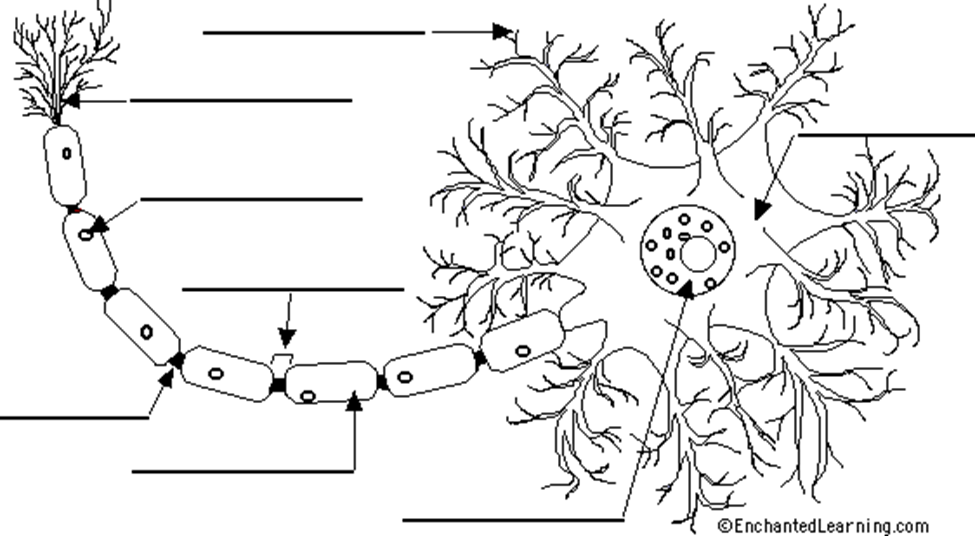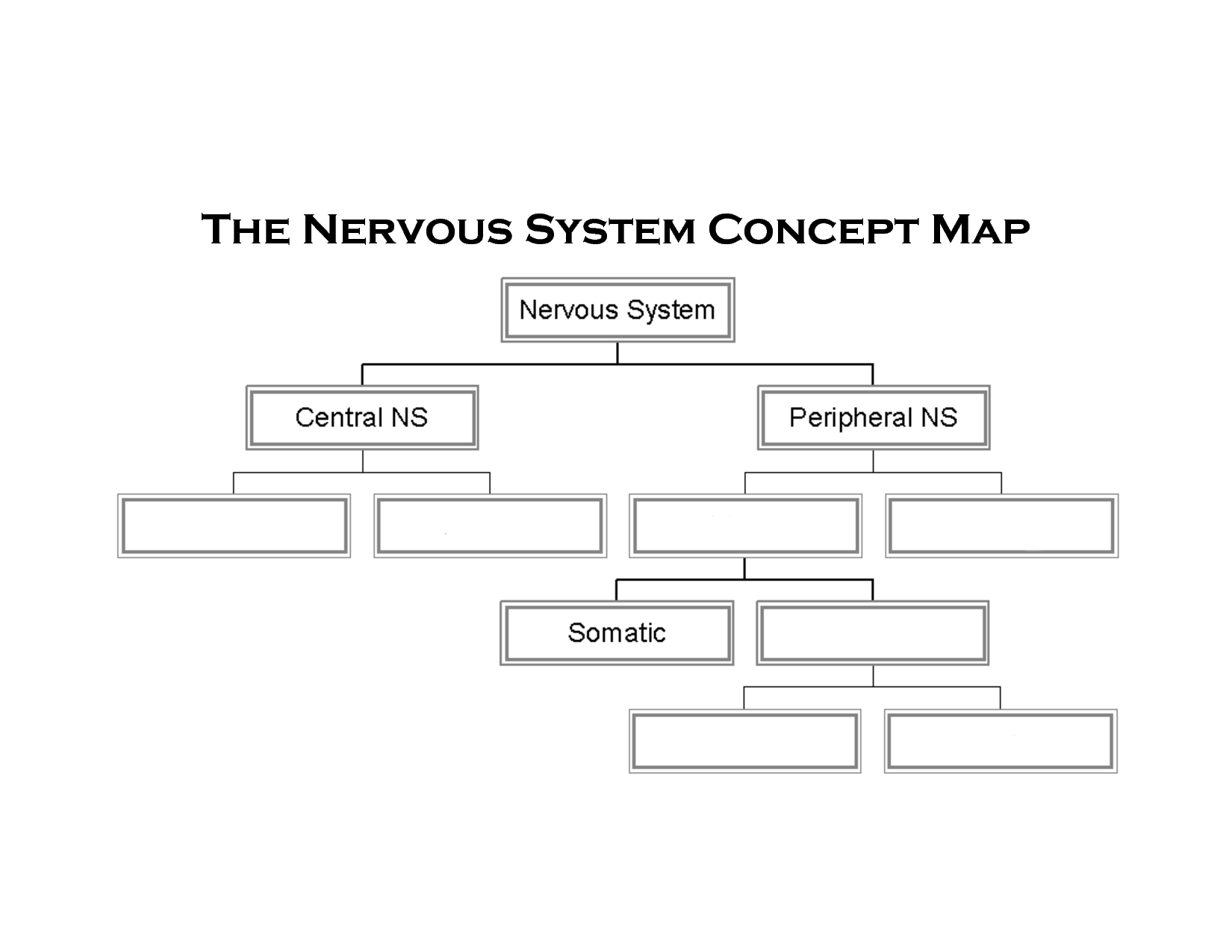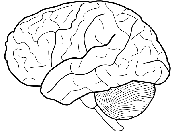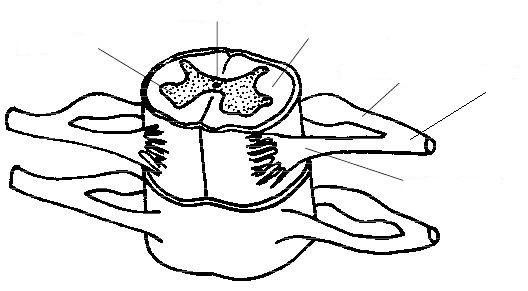- Учителю
- Worksheet ”Structure and functions of brain and spinal cord”
Worksheet ”Structure and functions of brain and spinal cord”
Worksheet " Structure and functions of brain and spinal cord "
Name ……………………………………………………………… Group B …. Date …………………..
Task 1. Use the descriptions below to label the different parts of a neuron.axon - the long extension of a neuron that carries nerve impulses away from the body of the cell.
axon terminals - the hair-like ends of the axon
cell body - the cell body of the neuron; it contains the nucleus (also called the soma)
dendrites - the branching structure of a neuron that receives messages (attached to the cell body)
myelin sheath - the fatty substance that surrounds and protects some nerve fibers
node of Ranvier - one of the many gaps in the myelin sheath - this is where the action potential occurs during saltatory conduction along the axon
nucleus - the organelle in the cell body of the neuron that contains the genetic material of the cell
Schwann's cells - cells that produce myelin - they are located within the myelin sheath.

Task 2. A. Choose the best responces that best correspond to the description provided in the following statements. Insert the appropriate letter or term in the answer blanks.
Key choises
A. Autonomic nervous system C. Peripheral nervous system (PNS)
B. Central nervous system (CNS) D. Somatic nervous system
________ 1. Nervous system subdivision that is composed of the brain and spinal cord
________ 2. Subdivision of the PNS that controls voluntary activities such as the activation of skeletal muscles.
________ 3. Nervous system subdivision that is composed of the cranial and spinal nerves and ganglia
________ 4. Subdivision of the PNS that regulates the activity of the heart and smooth muscle, and of glands?
It is also called the in voluntary nervous system
________ 5. A major subdivision of the nervous system that interpretrs incoming information and issuis orders.
________ 6. A major subdivision of the nervous system that serves as communication lines, linking all parts
of the body to the CNS.
B. Make a conceptual map
• The brain is enclosed in the cranium. 
• A layer of tissues called the meninges surrounds the
brain.
Task 3. 
-
Label the 3 major parts of the brain:
Cerebrum
Cerebellum
Brain Stem
-
Use the descriptions below to label the different parts of the human brain.
Frontal Lobe of the Cerebrum - the top, front regions of
each of the cerebral hemispheres. It is the largest part of the
brain. They are used for reasoning, emotions, judgment, and
voluntary movement.
Occipital Lobe of the Cerebrum - the region at the back of each cerebral hemisphere that contains the centers of vision and reading ability (located at the back of the head).
Parietal Lobe of the Cerebrum - the middle lobe of each cerebral hemisphere between the frontal and occipital lobes; it contains important sensory centers (located at the upper rear of the head).
Temporal Lobe of the Cerebrum - the region at the lower side of each cerebral hemisphere; contains centers of hearing and memory (located at the sides of the head).
Cerebellum - the part of the brain below the back of the occipital lobe of the cerebrum. It regulates balance, posture, movement, and muscle coordination.
Corpus Callosum - a large bundle of nerve fibers that
connect the left and right cerebral hemispheres. In the lateral
section, it looks a bit like a "C" on its side.
Medulla Oblongata - the lowest section of the brainstem (at
the top end of the spinal cord); it controls automatic functions
including heartbeat, breathing, etc.
Pons - the part of the brainstem that joins the hemispheres
of the cerebellum and connects the cerebrum with the cerebellum. It
is located just above the Medulla Oblongata.
Pituitary Gland - a gland attached to the base of the
brain (located between the Pons and the Corpus Callosum) that
secretes hormones.
Spinal Cord - a thick bundle of nerve fibers that runs from
the base of the brain to the hip area, running through the spine
(vertebrae).

Task 4
-
Label a diagram, using given words
spinal cord, grey matter, white matter, dorsal root, ventral root, sensory neurons, motor neurons, spinal nerves (31 pairs), central canal (cerebrospinal fluid)

-
Answer the questions
What are the spinal cord functions? ________________________________________________________________________________________________________________________________________________________________________________________What structures are these functions related with?
____________________________________________________________________________________________
____________________________________________________________________________________________
-
Using choices from column B indicate what would happen if the structures in column A were damaged or transected
-
_______1. Dorsal root of a spinal nerve
_______2. Ventral root of a spinal nerve
Column B
-
Lose of motor function
-
Lose of sensory function
-
The cerebrospinal fluid (CSF) is a clear, colorless fluid that bathes the entire surface of the central nervous system and cushions the brain and spinal cord against concussion or violent changes of position. It is contained within a system of fluid-filled cavities called ventricles. Since it's replaced several times a day, CSF flushes the central nervous system. (metabolism, a barrier to microbes and viruses)
Task 5
Meningitis is an inflammation of the meninges, the membranes that cover the brain and spinal cord.
Spinal injuries is damage to any part of the spinal cord or nerves at the end of the spinal canal
What are the causes, symptoms, consequences, prevention of these health violations?
Fill the table "The characteristics of Meningitis and Spinal injuries?
Spinal injuries
Task 6
Epidural anesthetics is the most popular method of pain relief during labor.
</<b>A lumbar puncture (LP) is a common medical test that involves taking a small sample of cerebrospinal fluid (CSF) for examination.
What are the advantages and disadvantages of these procedures? Fill the table
A lumbar puncture (LP)